#pointillist style
Photo
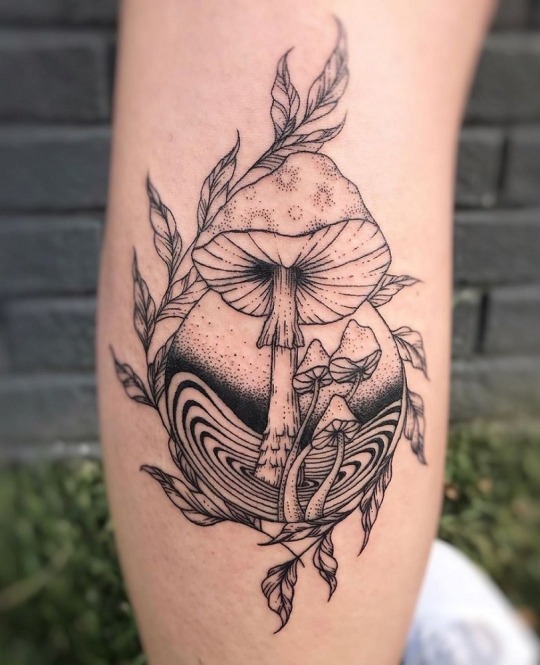
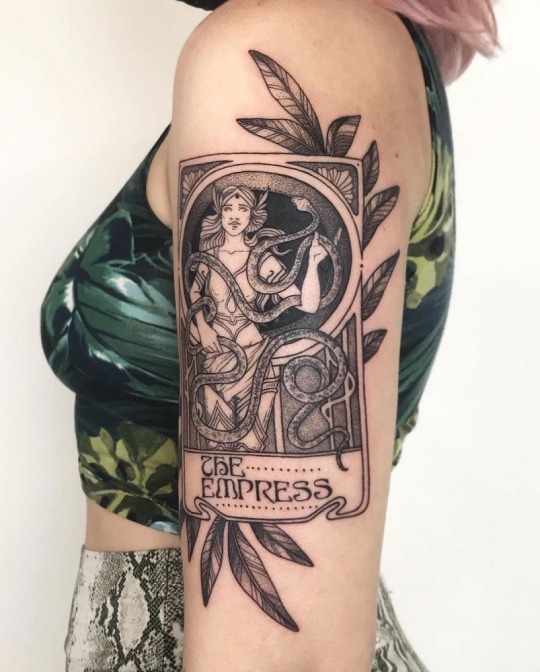
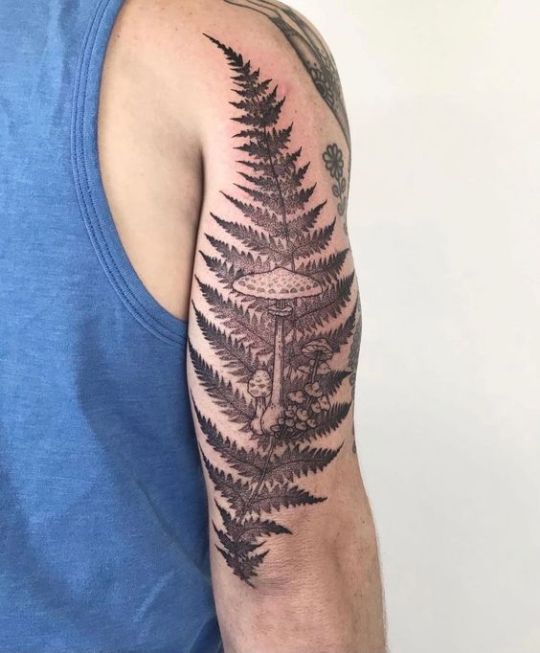
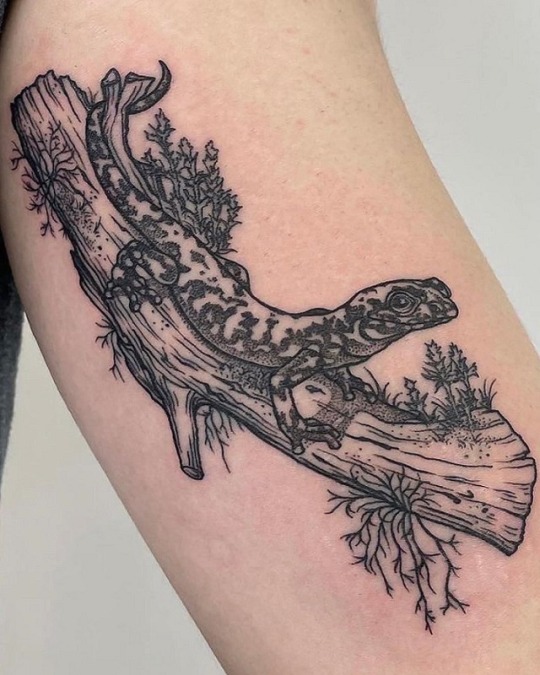

Phia Walla
#phia walla#tattoos#tats#inked#blackwork#nature art#so beautiful#tenderfoot studio#phia#body art#pointillist style
21 notes
·
View notes
Photo
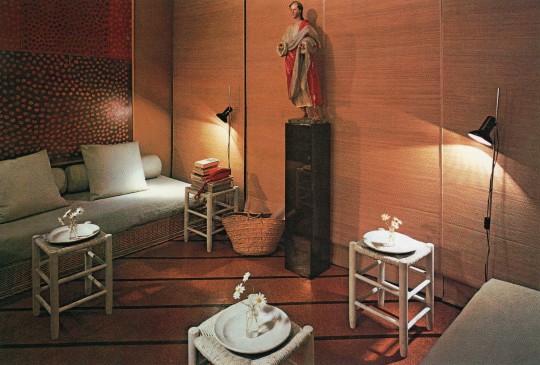
Focal point of the simplified Bed/Sitting Room is a Spanish Renaissance carved and polychromed wood figure of St. John; the early-17th century work has been attributed to El Greco. The pointillist painting is by Sr. Arango.
Contemporary Apartments, 1982
#vintage#vintage interior#1980s#80s#interior design#home decor#living room#stick shade#stool#pointillist#painting#Arango#Spanish#sculpture#El Greco#contemporary#style#home#architecture
114 notes
·
View notes
Text
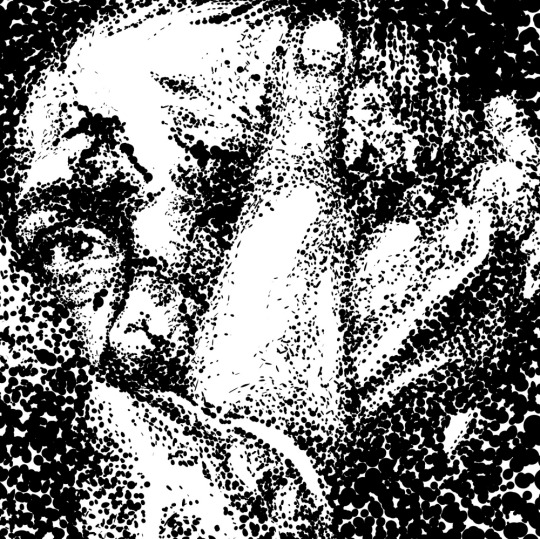
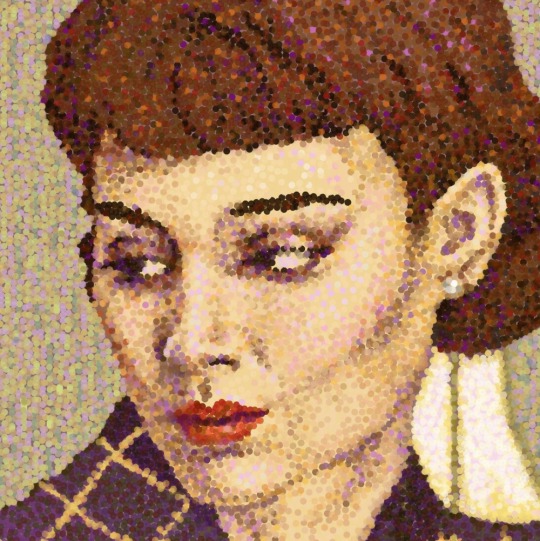


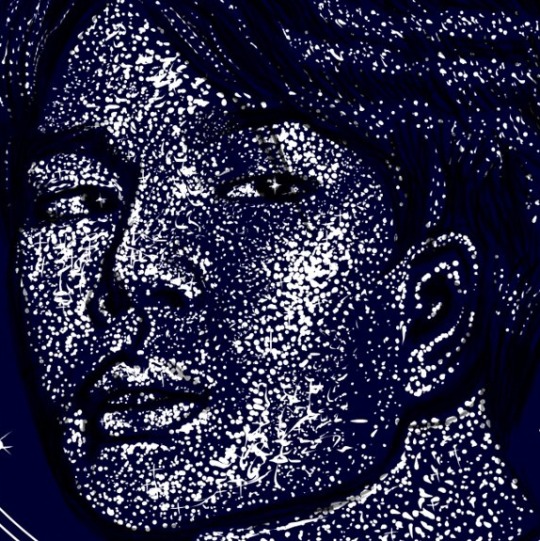
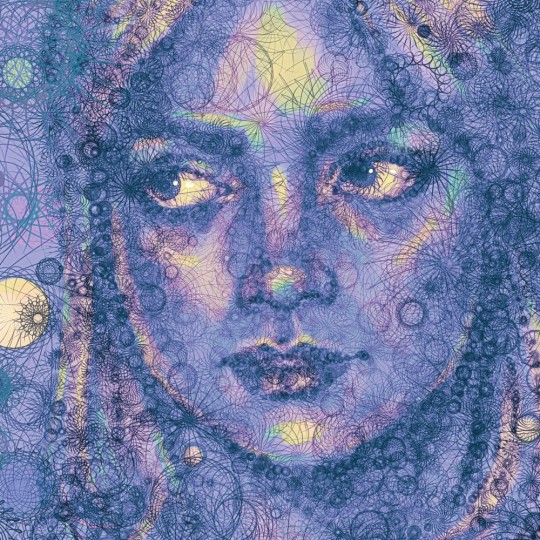
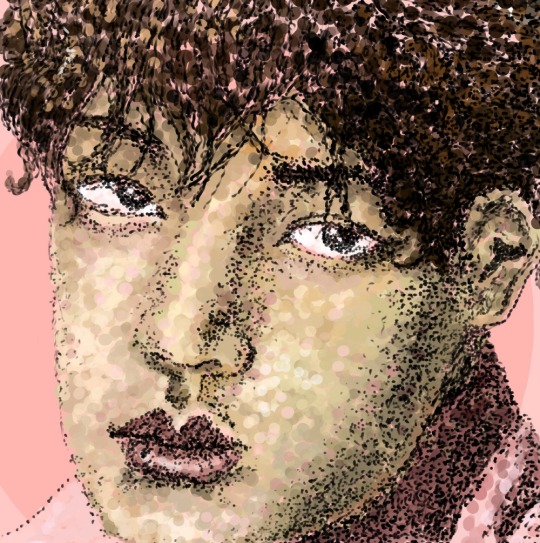
pointillism details from my artworks over the years ~
georges seurat eat your HEART out
(haven't actually uploaded one of these works yet so consider this a sneak preview lol)
#pointillism#pointillist#artists on tumblr#painting details#art details#portraiture#this is a style that i loveee the overall effect of#but the actual process is SO tedious and longwinded lol#btw the clara piece is a less conventional pointillist technique but i thought it still counted here lol!
18 notes
·
View notes
Text
Ranking the shirts from the Sealed-Environment Phase: Part 1
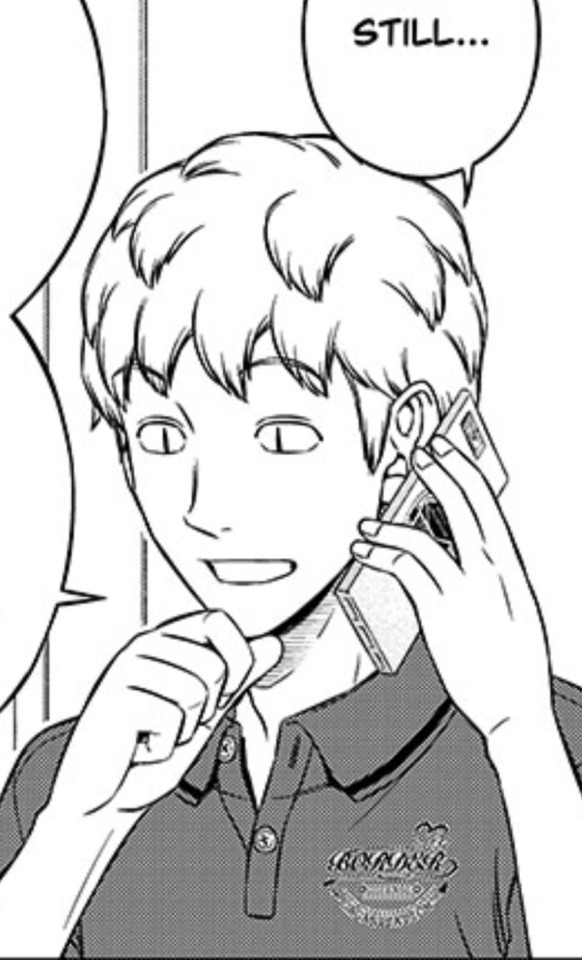
Fancy Border polo: 4/10
I like the trim on the collar, but the design itself is too fancy for it's size and placement.
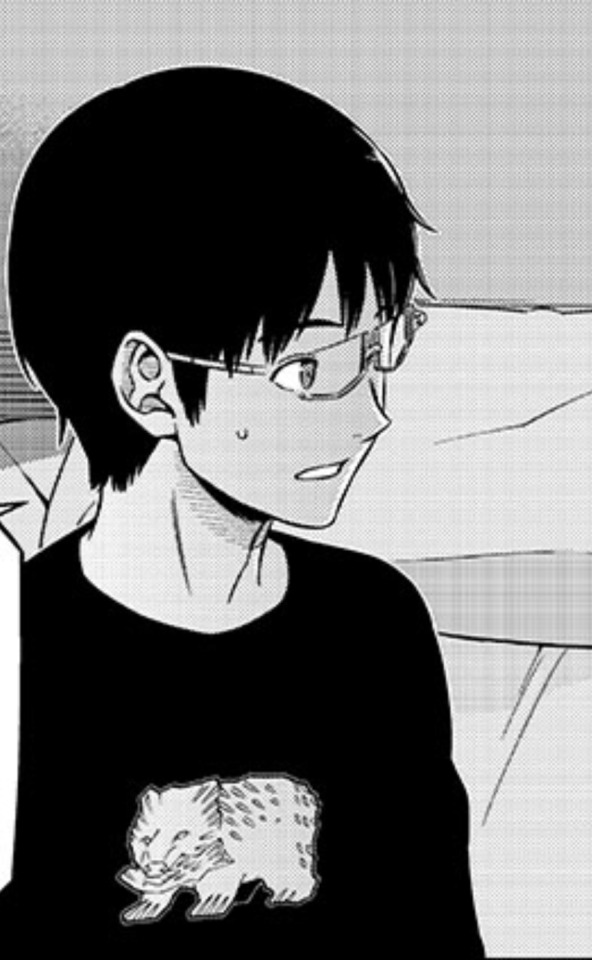
Mr Grizz: 7/10
It's a good design, but it doesn't grab me like some of the others.

Phone with arm: 9/10
Now this is a design! I'd wear this in real life.
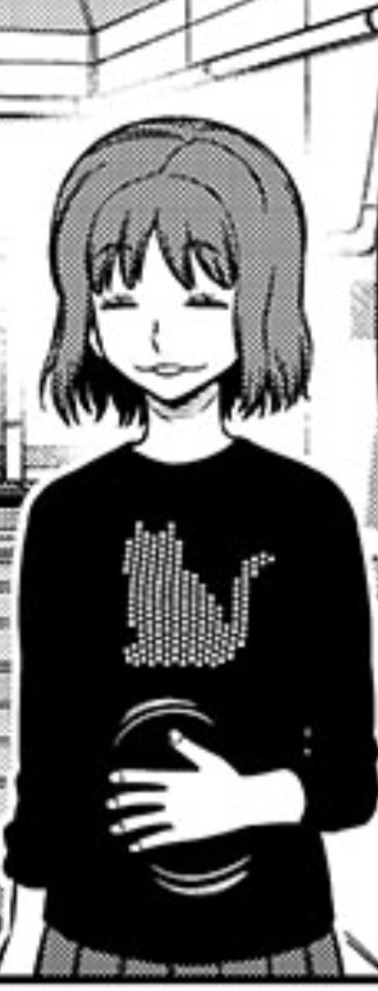
Pointillist cat: 12/10
Incredible. Showstopping. Miraculous. I'd buy this. I'd buy multiple of this, in pride flag colors.
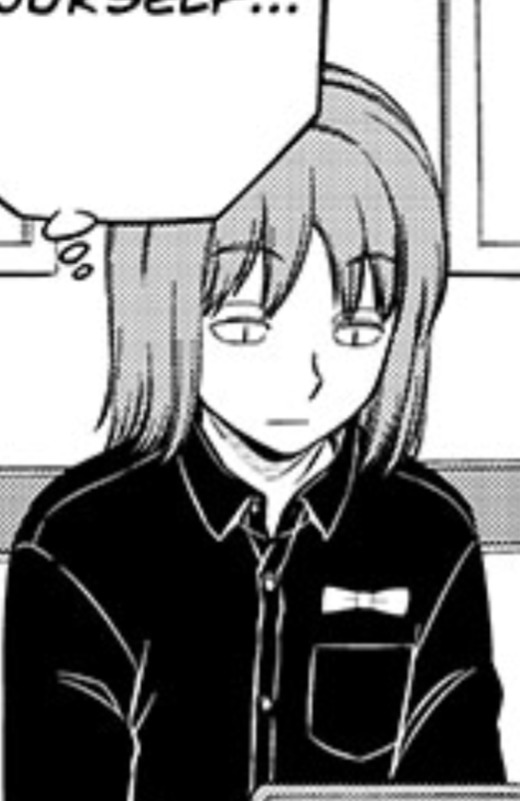
Bowtie button-down: 8/10
A shirt for shitheads. I love it.

Whale on fire: 7/10
I was going to give it a 6, then I noticed the flames.

Stylish dinosaur: 6/10
A good shirt, but not my style.

Fancy bird: 5/10
Again, design's too fancy for where it's placed.

Stylized peacock: 6/10
Better than the previous for having a sort of abstract stylization
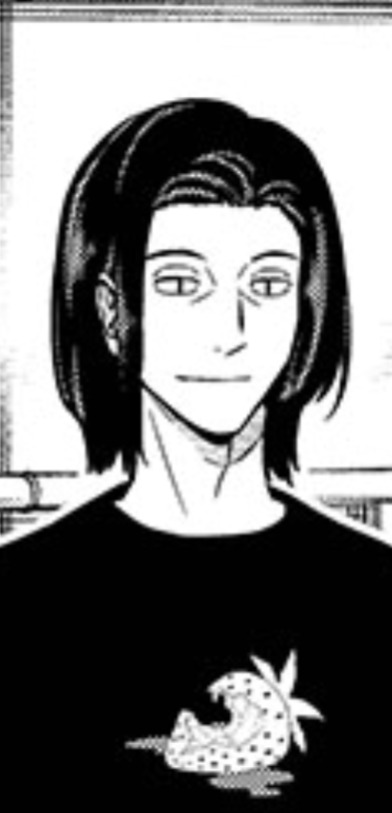
Strawberry bite: 8/10
The shirt of mysteries. Why is this strawberry so juicy? How did someone take that bite out of it?
#tatsuya kuruma#osamu mikumo#madoka ui#hiro kitazoe#rokuro wakamura#kazuki kurauchi#takuma yuba#haruaki azuma#world trigger
30 notes
·
View notes
Text
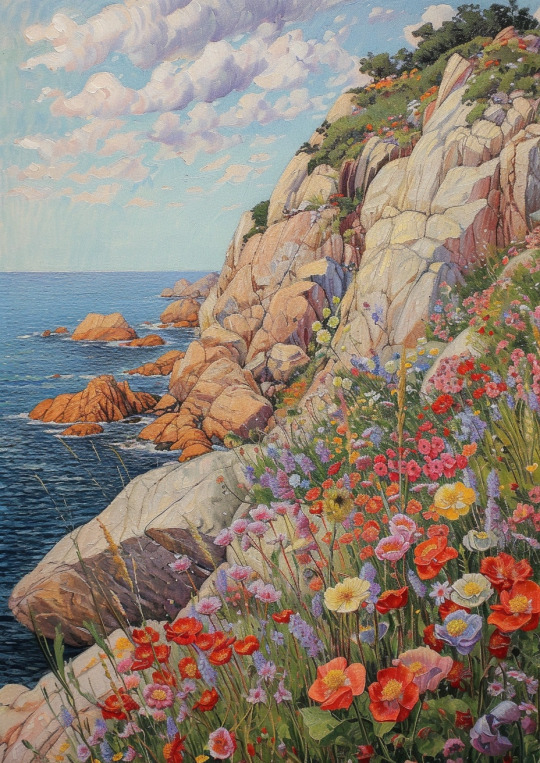



Prompt: a painting depicts flowers and a small body of sea and rocks on it, in the style of willard metcalf, light sky-blue and light red, charles robinson, light gray and red, jacques-firmin beauvarlet, embroidery, pointillist dots of color --ar 5:7 --v 6
#midjorneyart#midjourney#concept art#commercial illustration#ai art#scenery#flowers#floral#pink flowers#plants#prompt midjorney#prompt ai#prompt list#writing prompt#prompt
16 notes
·
View notes
Text



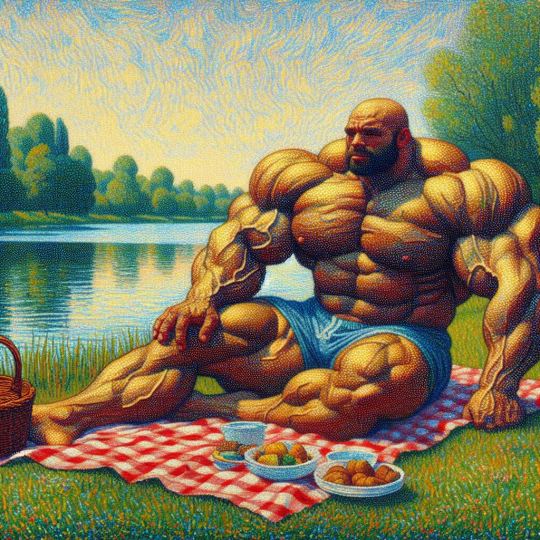

Bodybuilders having a picnic by a lake, in the pointillist technique reminiscent of Georges Seurat's style.
Bing AI Image Create
#bing ai#bing image creator#ai generated#ai image#ai muscle#ai bodybuilder#picnic by a lake#pointillist technique#georges seurat#ai art
12 notes
·
View notes
Text
Erik Parker.







Electrifying works from New York-based artist Erik Parker.
Parker's vibrant, surreal paintings blend aspects of traditional portraiture and landscapes with the visual styles of psychedelia, comics, and graffiti art. His neon-soaked scenes depict flowers, waves, and distorted faces. Early in his career, Parker's artwork featured dreamy patterns and embellishments composed of pointillist dots, teardrops, and paisleys. His exhibitions have spanned New York, Tokyo, Paris, Hong Kong, Los Angeles, and Copenhagen, with his work featuring in esteemed collections at the Whitney Museum of American Art, the Brooklyn Museum, the Museum of Modern Art, the Montreal Museum of Fine Arts, the Yale University Art Gallery, the RISD Museum, and the Hammer Museum. In addition to his paintings, Parker has designed skateboard decks, created round canvases known as tondos, and produced elongated, sculptural paintings displayed on pedestals.

THE SUPERSONIC ART SHOP | FOLLOW ON INSTAGRAM
47 notes
·
View notes
Text
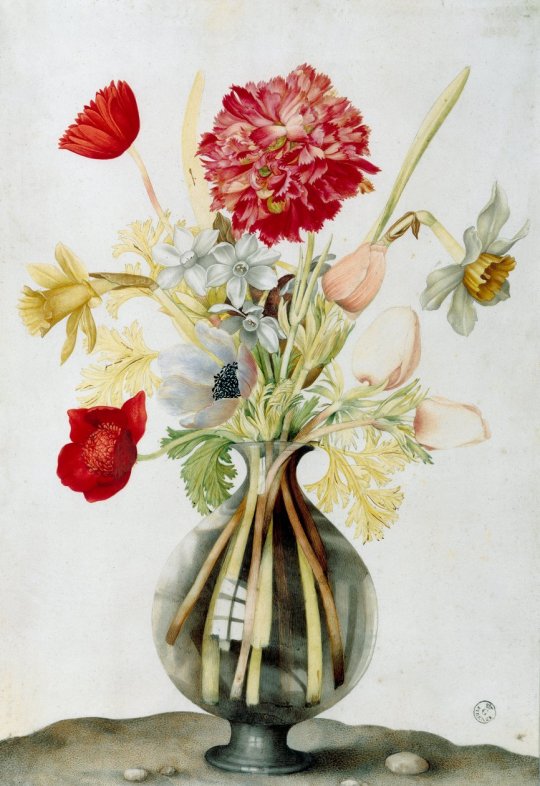
Vase of Flowers with Daffodils, Carnations and Anemones
Giovanna Garzoni (1600-1670, Italian)
Giovanna Garzoni was the daughter of Giacomo Garzoni of Venice and Isabetta Gaia of Ascoli, who also had Venetian ancestors. From 1615 to 1630 she lived intermittently in Venice, where she studied with her uncle Pietro Gaia, a student of Jacopo Palma the Younger , and with the calligrapher Giacomo Rogni. In 1622 she married the portrait painter Tiberio Tinelli, from whom she separated the following year.
In 1630 she traveled with her brother Matteo to Naples, where she entered the service of the viceroy Fernando Alfán de Ribeira. On the way to Naples she spent some time in Rome, where she came into contact with Cassiano Dal Pozzo. In November 1632, at Christina's request, she came to Turin from France and received a position at the court of Vittorio Amadeo I. She created numerous portraits for the court and her first known still lifes. After Vittorio Amadeo's death she left Turin and probably lived in Paris, possibly also in England.
From 1642 she lived as an established artist in Florence and worked particularly for the Medici. Her clients and supporters included Ferdinando II de' Medici, his wife Vittoria della Rovere and Leopoldo de' Medici. Giovanna was at the peak of her popularity at this time, selling many works and becoming somewhat wealthy.
In 1651 she settled in Rome, but continued to maintain contact with her clients in Florence. She purchased a house near the Accademia di San Luca, with which she was closely associated. It is unclear whether and when she was formally accepted into the academy, but from 1654 onwards she took part in the members' meetings. In her will of 1666, the childless Garzoni bequeathed her property to the Academy on the condition that a tomb be built for her in the church of Santi Luca e Martina. This tomb was created by Mattia de Rossi in 1698, 28 years after her death.
Giovanna created mainly works in tempera, watercolor and gouache on parchment, in addition to some oil paintings on canvas. Her motifs are portraits, calligraphy and fruit and flower still lifes, and from 1630 increasingly botanical motifs.
She developed a characteristic, almost pointillist technique between painting and drawing. In the style of English miniature painting, she placed many tiny dots with a special brush and delicate, dense strokes on the parchment. Her works, based on the still life tradition of Orsola Caccia, Panfilo Nuvolone and Fede Galizia, show fruit and vegetable peels, often combined with flowers, animals or foliage in a simple, symmetrical structure. Her floral still lifes are varied and display an extraordinary wealth of color.
From around 1630, Giovanna's pictures show a naturalistic, non-idealized representation of plants and animals that correspond less to contemporary still life painting than to natural history painting in the tradition of Dürer or Leonardo or to the model of Jacopo Ligozzi. Giovanna was obviously knowledgeable in botany and also created illustrations for flower books.
Giovanna's other works: http://www.artnet.de/k%C3%BCnstler/giovanna-garzoni/
#dianthus#carnation#daffodils#anemones#painting#still life#flowers#flower vase#glass vase#women in art#woman painter#woman artist#17th century art#17th century painting#italian art#giovanna garzoni#reflex#woman artwork#fine art
3 notes
·
View notes
Text
MJ Describe Vs Clip-Interrogator 2.1
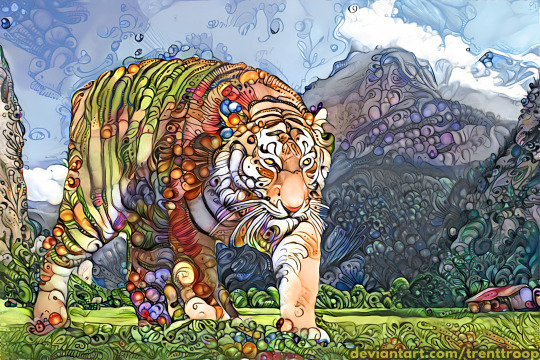
Describe and Clip Interrogator are both AIs that examine pictures and break them down into image prompts. The two approach the task from different intents, however, and using them is the best way to demonstrate. We'll start with "Natural Beauty", a style transfer piece I made a bit over a year ago.
To be extra-studious, I'll use the same seed on all of them, all gens made in Midjourney V5.
Clip Interrogator:

Prompt: a large tiger standing on top of a lush green field, inspired by Augustin Meinrad Bächtiger, deviantart contest winner, sumatraism, colorful intricate masterpiece, in a style blend of botticelli, highly detailed generative art, stained glass art, vibrant cartoon art, mountain, walk, 7 0 mm. digital art, much detail, devainart
Lengthy, detailed, prompt, with results that are kinda in the vibe. A few almost seem like they're made of fruit and plants like the original.
Midjourney Describe:
Describe gives four prompts per "ask" and re-rolls them (while Clip Interrogator seems to use a single seed).

Prompt: tiger is walking around through a forest in a colorful drawing, in the style of intricate textures, vibrant cartoonish --ar 3:2
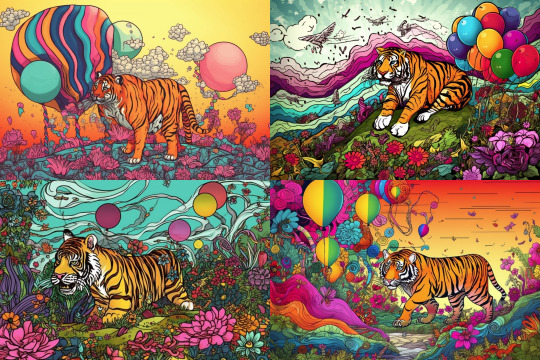
Prompt: a tiger with colorful balloons and flowers in its body, in the style of intricate psychedelic landscapes, organic texture, flickr, abstracted nature, furry art, colorful comic strips, intricate landscapes --ar 3:2

Prompt: eloe zoe's new book 'tiger psychedelic tiger', in the style of digital painting, pointillist landscapes, digitally enhanced, colored cartoon style, david choe, anna dittmann, saturated color fields --ar 3:2

Prompt: tiger walking in the grass in background, in the style of intricate psychedelic landscapes, colorful caricature, large canvas sizes, digital art wonders, commission for, precisionist art, digital art techniques --ar 3:2
From the results, you can see the difference. Clip Interrogator is, arguably, closest in style and tone to the original. Midjourney's results have more "chaos" in them, and are clearly intended to be more for iterating new semi-related variants of a concept rather than imitating directly, which keeps with the specific design of a lot of MJ's features.
The images autogenerated for this post are in the public domain, as they do not meet the threshold for minimum human expression. I've put them all in their own post here.
#midjourney v5#midjourney#midjourney describe#clip interrogator#tiger#ai art#ai artwork#ai experiments
26 notes
·
View notes
Text

Growing up between Cornwall and London, Riley studied at Goldsmith's and the Royal College of Art. Like many artists, she explored different painterly styles, including impressionist and pointillist painting. The latter led her to work part-time as an illustrator for an advertising company.
In the 1960s, Riley started exploring the potential of optical illusion in art. Inspired by Seurat's pointillist style, in which he created an image through small dots of colour, Riley developed a different, more dynamic approach through patterned works comprised of lines and dots. Working initially in black and white, she only introduced colour in 1967.
Her solo exhibitions and a series of overseas shows in 1964 secured an international reputation. She won the International Prize for Painting at the 1968 Venice Biennale and had retrospective shows at the Hayward Gallery (1992), the Tate (1994) and the Serpentine Gallery (1999).
Ph Bridget Riley by Edward Lucie-Smith, circa 1970 © Edward Lucie-Smith / National Portrait Gallery, London
2 notes
·
View notes
Text
ARTWORK
Georges Seurat
Final Study for "Bathers at Asnières", 1883
Chicago Institute of Art

Georges Seurat made this painting as the last of several preparatory works for his monumental Bathers at Asnières, now in the National Gallery, London. The artist carefully researched and planned each study to perfect the composition before starting on the final canvas. The work adopts the Impressionists' interest in subjects from modern life, showing men and boys on the bank of the Seine River in Asnières, a working-class Parisian suburb.
It is also painted with the airy brushwork associated with Impressionism, but the multiple studies and intense planning foreshadowed the meticulous pointillist style the artist developed for his best-known work, A Sunday on La Grande Jatte—1884 (also on view in this gallery).
What I connect with…
I studied this in art history, lovely seeing this preliminary sketch, as well Seurat's other works in this collection.
2 notes
·
View notes
Photo

a vulture demoness wrestler wearing a necklace.
the new art meme is paint your oc/fursona whatever in the divisionist/pointillist/neoimpressionist style. use #neoimpressionistchallenge to tag your work! i hope you join in!
#art#painting#digital art#digital painting#neoimpressionistchallenge#portrait#vulture demoness#anthro art#furry art#avian#vulture#anthro#furry#neoimpressionism#divisionist#pointillism#dynasoar5#ssohardd#r crumb#female furry#wrestler
34 notes
·
View notes
Text



Clara Oswald - digital drawing ~
(02/2023)
I can't believe I've been a fan of doctor who for like... forever and yet this is the first time I've drawn clara!
(btw this portrait was done with the 'symmetry rotate' brush on firealpaca to create a sorta pointillist style!)
#artists on tumblr#doctor who fanart#clara oswald#doctor who#drawing#digital art#portrait#dw fanart#jenna coleman#pointillism#it was such a struggle to make her hair look right tbh... i really enjoyed this technique though i definitely wanna do more stuff like this#the symmetry rotate brush reminds me a lot of spirograph which is LOVED doing as a kid lol#the digital version of it is infinitely easier though pfft
52 notes
·
View notes
Text
The Kite Artist

There are some coastal towns which are famed amongst tourists for their postcard-perfect views, beloved by families for their sandy beaches and amusement arcades, or renowned by surfers for their fearsome five-foot waves, but the bay around St Triston has always been known for its artists.
Every summer, they flock like gulls to the apartments that cluster in a horseshoe looking out onto the sea, and spend their days soaking in the golden light that rises over the harbour. They travel here from miles away to make their own attempt at capturing that perfect dawn, the way the sunbeams dance across the cresting of each wave, as many famous painters have set out to in the past. In doing so, however, they often find it captures them instead.
That was why they always came back. There were only so many way to capture the idyllic blue-green of a rising swell, the glittering silver of the crashing surf, but each artist felt the need to paint the same landscape again, and again, and again. They tried different materials, watercolour or acrylic, even glass-blowing or sculpture, and styles from a delicate pointillist foam to a fauvist's vivid strokes, but none sufficed to satisfy that appetite.
Their recreations would never be enough. They were entranced by the real thing - enthralled - ensnared, like a herring at the end of the fisherman's line. Some of them might migrate north in the winter months, huddled safely by a fire somewhere inland, and even imagine themselves free. But when summer sang its siren song, they found themselves reeled back down to their second home, to St Triston, summoned to paint its portrait once again.
The town's narrow streets were filled with minor galleries, nestled in the corners between fudge shops and tea parlours, where a visitor might sample any number of differing depictions of the view a few short steps away, able to judge for themselves which attempt best did it justice and then baulk at the price of taking that memento home. It was a common way to pass the time, between light café lunches and long strolls out to the pier.
But Pia preferred to walk along the promenade. The long, sheltered beach that accompanied the esplanade was home to a different breed of artists, those who made their works out of the beach itself. Sand-sculptors, who spent their days buildings castles beyond her own childhood dreams, vast palaces complete with turrets and a curtain wall, and an entire portfolio of other forms besides.
She saw a golden retriever formed from sand alone, its fur lovingly beach-combed into life. A sea turtle mounded into shape, its carapace a mosaic of other shells. An octopus whose tentacles were made to rise and disappear beneath the surface of the beach. Many of them were familiar. Pia's family visited St Triston every summer, and some of the artists were present year-on-year, endlessly creating their temporary art: Sisyphus with a hammer and chisel, or in this case a bucket and spade.
Her favourite used to be the kite-boy. The seafront always bore a healthy breeze, and one artist was out there early every day, flying a kite upon the sands. She was an older woman, wrapped up in thermals and gloves, but there was no faulting her dedication: she'd never missed a day, as far as Pia could remember, and she'd been to watch her work on every morning they were staying there. At least she had, up until the day she'd had to stop.
It always started with the kite. A perfect diamond tiled with stones, a bladder wrack string with oarweed ribbons. The boy came next, painted in pebbles of different hues so that the sun appeared to shine upon his cold grey cheeks, his smile an arc of seashell teeth, a pair of softened seaglass eyes. The exact design varied day-by-day, but he was always perfect, and it had always given Pia a smile to see such a loving depiction of childhood innocence amongst the masterpieces on the beach.
Every morning, she went out to watch the boy fly his kite. Sometimes she went back later, as the tide came in, as fledgling waves were dashed across his pebble-dashed boots, a duvet drawn to tuck him gradually beneath the waves. Or sometimes he was painted upside-down, the kite drawn like an anchor that pulled towards the ocean - on those days, the churning tide consumed him head-first, leaving only two vast and trunkless legs of stone.
Other details changed from one dawn to the next: when emerald seaglass had been scarce, the child's eyes were the pearlescent white of upturned scallop shells, or glinted with the sheen of coins tossed down by passers-by, the artist's payment to the boatman who would take the kite-boy home. Pia had always sought out those changes with keen eyes of her own, looking forward to each day's fresh interpretation whilst the sand sculptures remained identical throughout the week. That was why he had always been her favourite.
But that had been until last summer, when she'd overheard a couple pass behind her on the esplanade, and learnt the awful truth behind this particular muse.
"Oh no, that one's a bit morbid, don't you think?"
"What do you mean?"
Pia had been watching the artist work, but she spun around at that exchange, suddenly hooked by these strangers' conversation. It was all that she could do not to ask Why? herself - her instinct to defend the kite-boy and his honour. She'd spent so much time with him, in his various guises, that she felt a certain attachment to the piece, even as it was washed away and rebuilt every day.
"There was a boy who drowned, not far from here, wasn't there?" They'd been an elderly couple; perhaps locals, perhaps artists, perhaps there for a holiday themselves. "He was flying a kite, and it pulled him into the sea?"
"Oh, gosh. Now that you mention it, yes, I did hear something about that. That's awful. You think that the artist knew?"
"It would be a strange coincidence, wouldn't it? I'm sure they mean it in the right way, but it seems a strange way to honour his memory. Recreating the way that he died."
Pia looked out towards the sea, considering the sculpture not in the golden glow of the famous St Triston dawn, but the new light of these revelations. She hadn't heard about the drowned boy. Perhaps it had been before her family had started visiting; perhaps she'd been too young to be told, and they'd just kept her closer to hand, and hugged her extra tight before bed for a few weeks afterwards.
She searched the waves for his final resting place, if it had been here, but it would be impossible to tell. There could never be a marker there, in the ever-changing patterns of the surf. If a tribute was meant, the beach was the only setting - and why not a sculpture out of pebbles and shells? A hundred tiny headstones, arrayed in a graveyard all his own. The remains of lives washed out of the sea, in exchange for one it had claimed for itself.
Pia tried her best to justify it, but she couldn't help but share the feeling it was wrong, permanently tainted by this knowledge. Would flowers have been more appropriate? She saw them at the scenes of other tragedies, on corners following a recent car crash, but even the most beautiful bouquet would die and decompose with their intended. Was that better than capturing the boy like this: alive, and lost in this moment of innocent joy? A sculpture that was made anew each day, so that his memory would never be forgotten?
She didn't know why, but it felt like it was. This felt... well, morbid, as the couple said. Disrespectful. The intention sounded good on paper, but perhaps some memories were meant to fade with time - the dead deserved to rest, and their families with them. Most headstones wished their tenants peace, not constant re-enactment of their lives, and let alone their deaths; flowers left upon a grave would wilt and shed their petals with their mourner's tears, but perhaps they were a gentler tribute for their transience.
"I wonder if the family know," one of the strangers said. Pia found herself walking slowly after them, not wanting to lose the end of their conversation. Leaving the kite-boy behind. "What must they think?"
"I read at the time that his father had a drinking problem, which was why the boy was left to entertain himself. The papers blamed him, and I dare say that he probably blamed himself. I don't know that he'd be in much a state to complain."
"And the mother?"
"Who knows."
His mother wishes that she'd been there, the kite artist thought, listening as their conversation faded away into the crowd, just as a sculpture gradually cedes into the sea. She wishes that she could have saved him. But even if he had to die, she wishes she'd had the chance to hold his hand, to be there for him as he went, to say her last goodbyes. To tell him he was loved, and that there wouldn't be a day she wouldn't wake with his reflection in her heart.
Now, Pia spent her time further down the front, throwing her arcade change to other artists - those that didn't make her feel uncomfortable, or raise those questions in her mind. The kite artist noted her absence, having become familiar with her visits every year, but she observed it in the same silence with which she watched the dawn rise over the sea. She didn't mind being left to work alone. This wasn't something that she did to be observed.
Even in the winter months, when St Triston was all-but-empty and a harsh wind whistled through the sands, she was glad to have been left to make her morbid art in peace. To stroke her kite-boy's cold grey cheeks, assembled lovingly in place, to hold his outstretched hand as the first waves came lapping at his shoes. They would never be apart for long. She would never not be there, as she'd vowed when the news first tore her world in two. She would never forget about him again.
A hundred headstones to his grave, and a hundred more tomorrow.
9 notes
·
View notes
Text

13/1/23. Sketch ready to start pointillist style paining. Sorry it looks so faint in photo.
7 notes
·
View notes
Text

Prompt: aerial interior view, vast hottub of the gods, ornate persian architecyure, steamy water and wondrous bubbles, epic jacuzzi hot tub, indoor waterfalls, volumetric light, ambient occlusion, sprawling architecture interior, intricate and detailed, concept art, 8k --ar 2:3 --iw 0.45 --aspect 2:3 --stylize 1250 --style pointillist painting by Henri-Edmond Cross --chaos 25 --no sepia, blur, dof, text, watermark --testp --creative
thunderlight
midjourney
11 notes
·
View notes